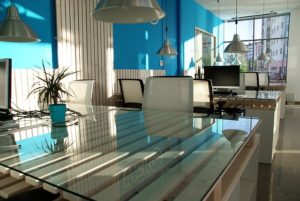 Lighting an office is a lot more nuanced than simply having enough light for you to see things in general. With office lighting standards, energy guidelines, and office designs changing over the years, choosing the right light bulbs and fixtures has never been more completed—that is, if you want an office setup that helps your employees be productive.
Lighting an office is a lot more nuanced than simply having enough light for you to see things in general. With office lighting standards, energy guidelines, and office designs changing over the years, choosing the right light bulbs and fixtures has never been more completed—that is, if you want an office setup that helps your employees be productive.
There are a number of things to consider when lighting offices effectively. Here are four things you need to know before getting started.
Standards
Most countries have some sort of office facility standards that they follow. For example, the US General Services Administration (GSA) notes that every type of work environment requires a certain amount of light.
Case in point: office lights have a standard of 500 lumens per square meter. That means that a 6’x 6’ cubicle needs at least 500 lumens or the same amount of light you’d get from a 35-watt incandescent bulb. How the light fixtures are laid out also matters. For one, they should be laid out in a way that evenly illuminates the whole office space. The layout should also minimize shadows casted by partitions or cubicle walls.
Computers and Lights
Having a well-lit space while working on a computer is vital. It helps alleviate headaches, irritation, fatigue, eyestrain, and makes tasks simpler to perform.
On the other hand, having too much light isn’t a good thing either as it can cause glare on computer screens. Be sure to avoid placing computer monitors against contrasting light sources such as windows and floor lamps, or directly under the light or lamp. Staff should be given task lights, like a small desk lamp, that they can use and adjust accordingly to their preference.
Ambient Lighting Is Key
Gone are the days where staff are locked into cubicles. Today, modern offices and workspaces now have open designs.
Workplaces now have a clean, sleek, open-office environment where staff can simple reach over to another table to interact their co-workers. With this design, ambient light plays an important role. Ambient or general lighting then needs to be bright enough that it illuminates the whole floor while making it feel more welcoming and relaxed.
One can achieve this look by using light bulbs with warm color temperatures and fixtures that help evenly spread the light in the space.
Savings and Energy Use
Offices and businesses have a social responsibility to use less energy and produce less waste. You might not notice it, but
running an office can a huge impact on the environment.
Thankfully, there are energy efficient light bulbs and fixtures in the market that are perfect for offices. LEDs or light-emitting diodes are front liners in this regard, becoming one of the most popular choices amongst consumers and businesses. LEDs use a fraction of the energy used by incandescent bulbs and compact fluorescent lamps, have life spans over 15,000 hours, and generate very little heat.
Keep these things in mind when setting up your office lighting, When in doubt, talk to a lighting designer to come up with a setup that works for you and your employees.

![3 Features to Expect from a Smart LED Light Bulb [city]](https://eepros.com/wp-content/uploads/2017/01/home-1285134_640-300x200.jpg)
![Demystifying LED Terminology: 12 Words You Need To Know [city]](https://8blocks.s3-us-west-1.amazonaws.com/eepros/2020/social.jpg)
![What You Need to Know When Choosing Between HID and LED Car Headlights [city]](https://eepros.com/wp-content/uploads/2017/09/pexels-photo-53756-300x200.jpeg)
![5 Practical Lighting Tips That’ll Work in Any Dining Room [city]](https://eepros.com/wp-content/uploads/2019/01/kitchen-2400367_640-300x200.jpg)